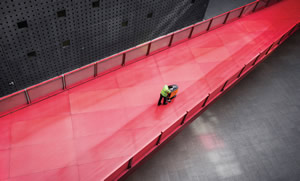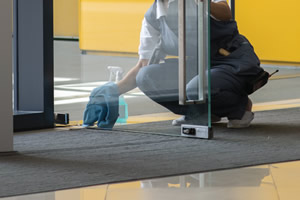How Clean?
 When it comes to who cleans public and private colleges and universities throughout the U.S., the answer typically falls into one of three categories:
When it comes to who cleans public and private colleges and universities throughout the U.S., the answer typically falls into one of three categories:
- Custodial workers hired directly by the institution; this is referred to as “in-house” cleaning.
- Custodial workers work for a cleaning contractor that has been hired to clean and maintain the facilities; this is referred to as “outsourced” cleaning.
- A combination of both is used, with some custodial workers who are in-house and others who are outsourced.
Whatever program your institution has in place, if cleaning expectations are not being met, you as an administrator should not immediately assume this is the fault of the cleaning workers. Instead, take a close look at what the cleaning workers are expected or have been told to do.
What is the Scope of Work?
What we are referring to here is called the “scope of services” or the “scope of work” agreement. According to Ron Segura of Segura & Associates, a cleaning consulting firm that works with schools and universities in North and South America, a scope of services agreement can be defined as follows: “A listing of all custodial services to be performed by the cleaning workers on a daily, weekly, monthly, quarterly, and annual basis.”
This includes everything from nightly vacuuming to cleaning carpets or light fixtures every few months. It can also be used to create a “cleaning culture,” ensuring that all cleaning workers know the focus of their job is to keep the campus clean, healthy, and safe.
“If cleaning expectations are not being met, it is very likely there is no scope of services or the ‘scope’ in use is outdated,” says Segura. “Cleaning has changed considerably in the past decade. It’s essential to have an up-to-date scope.”
For instance, Segura says he works with many schools and universities that still require that floors be stripped and refinished two or more times per year, per their scope of services. With new floor finishes and new floor care procedures, this is no longer necessary. “This costs money, is environmentally unfriendly, and takes cleaning workers away from other duties that could help improve cleaning expectations.”
A bigger problem than an outdated scope of services is when there is none at all. The scope of services is necessary for in-house cleaning workers “because it tells them exactly what is expected of them,” says Segura. “View it as their job description.”

PHOTO © IAMSUTHICHA
WHAT IT’S ALL ABOUT. In a 2015 dissertation written at the University of Iowa (“Mutually Beneficial Interactions: Campus Custodian-College Student Relationships”), Jeremy John Reed observes that mutual benefits to both student success and custodial staff occupational esteem have been identified in custodial staff-student interactions. More specifically, custodial staff members were found to indirectly support student success by formally acknowledged and performed cleaning and maintenance duties of observing, protecting, and promoting the health of college students. Sharing with custodial workers a customer-focused approach that includes appreciation of their role in student success may contribute to improved worker morale.
And when outsourcing cleaning, Segura adds, “the entire request for proposal (RFP) process is based on having an up-to-date scope of services. Without it, contractors cannot submit a proposal that adequately meets the needs of the school.”
Meeting Cleaning Expectations by Improving Worker Morale
Earlier, Segura mentioned that one function of the scope of services is to help establish what he calls a “cleaning culture.” Once established, this cleaning culture can help ensure that cleaning expectations are met. However, this can be easier said than done.
Sometimes cleaning expectations are not being met due to poor worker morale. Making matters worse, very often administrators are the last to know of the situation, or at least the “inside story,” from the custodial workers’ perspective.
“When worker morale is low,” says Segura, “often there is bickering among the cleaning workers, they gossip about other workers and their supervisors, workers become territorial, and an undercurrent of fear is developed. No one works well in such situations, especially custodial workers.”
When such an atmosphere exists, Segura suggests allowing workers to come forward—discreetly—to discuss their grievances. In one low-worker-morale situation, he accomplished this by placing a suggestion box in a lunchroom on a set day each week. The cleaning workers were encouraged to leave a note in the suggestion box discussing job-related issues and concerns, all of which would later be addressed in a safe, constructive manner.
“Interestingly, what happened over time is that many of the unhappy cleaning workers who simply did not like working for this organization left,” he says. “The others worked out their differences. The result was that morale was lifted, cleaning improved, and cleaning expectations were met.”
Meeting Cleaning Expectations With Machines and Technology
In September of 2015, Research and Markets, an international research organization based in Dublin, Ireland, analyzed the current situation of the U.K. professional cleaning industry. While their report, “The Contract Cleaning Market Report—UK 2015–2019 Analysis,” did focus primarily on the U.K., many of their findings apply to the U.S. as well.
The report discussed several critical issues now facing the professional cleaning industry. As to staying cost competitive and meeting future cleaning expectations, the researchers concluded the industry must take the following steps:
- Use more “powered” cleaning machines,
- place a greater focus on improving cleaning efficiency, and
- increase automation of cleaning processes.
All three of these trends are interconnected. Using “powered” cleaning equipment means replacing traditional, manual cleaning methods with machines designed to perform the same work. What we have seen is that these powered machines have been able to improve not only cleaning efficiency but also cleaning effectiveness.
A perfect example of this is what ISSA (International Sanitary Supply Association), the worldwide cleaning association, calls spray-and-vac cleaning.
Many schools and universities have transferred from having custodial workers manually clean restrooms and floors using cleaning cloths, sprayers, and mops, to having that work performed using spray-and-vac cleaning systems. These machines, available in one form or another from different manufacturers, apply cleaning solution directly to restroom surfaces and fixtures to be cleaned. The same areas are then power-rinsed clean and, at least with some machines, the moisture and soils are vacuumed up, leaving the restroom dry in minutes.
ISSA says using spray-and-vac machines is as much as twothirds faster than conventional cleaning systems and as much as 60 percent more effective at removing soils than mopping.
As for automating the cleaning process, artificial intelligence (AI) is playing a growing role in the professional cleaning industry. As it becomes more common, this should also help schools and universities meet cleaning expectations. The big benefit of AI systems, according to Segura, is that they can be used to perform “repeatable” cleaning tasks, usually in larger settings.
One example of this is a new generation of automatic floor scrubbers that can be taught how to clean floors such as in long hallways. “The machine is equipped with cameras, sensors, a navigational mapping system, and a data storage system,” explains Segura. “The machine is ‘taught’ what to do and remembers what to do so that the same cleaning routine can be performed over and over again.”
Other AI technologies in the pipeline that are also expected to help improve cleaning effectiveness and address cleaning expectations are:
- Systems that monitor the cleanliness of restroom fixtures and send out real-time alerts, either by text or email to smartphones or other devices, that a restroom needs cleaning attention.
- Systems that monitor conditions such as malodors in restrooms or overly wet floors and counters, requiring cleaning attention.
- Devices that monitor paper supplies in restrooms and kitchen areas.
Systems that monitor cleaning workers are also coming online. They can tell when a cleaning worker has entered a facility or specific area in a facility and when he has left. This information can prove valuable in regard to worker productivity as well as help ensure worker safety.
Administrators and cleaning crews have many options to ensure cleaning expectations are met on campus. Unfortunately, there is not one silver bullet to accomplish this. If cleaning does not meet expectations, examine carefully why this may be. Most likely, there are several factors involved. But in most cases, with thoughtful interventions, these challenges can be addressed.
APPA CUSTODIAL OPERATION SELF-ANALYSIS SURVEY
In helping to transform member institutions into more inviting and supportive learning environments, APPA: Leadership in Educational Facilities seeks to create positive impact by offering resources to campus managers. One resource available from APPA’s website is the Custodial Operation Self-Analysis Survey.
This survey and self-analysis tool was designed to identify most of the variables that impact institutional custodial operations, as well as to establish some reliable standardized benchmarks for the industry. It will help facilities managers to better understand custodial costs and staffing levels. This survey was developed to supplement APPA’s publication, Custodial Staffing Guidelines for Educational Facilities.
The survey is available for download here: appa.org
This article originally appeared in the College Planning & Management June 2018 issue of Spaces4Learning.